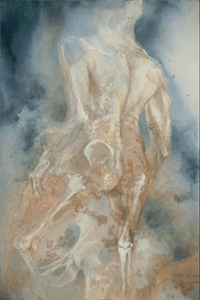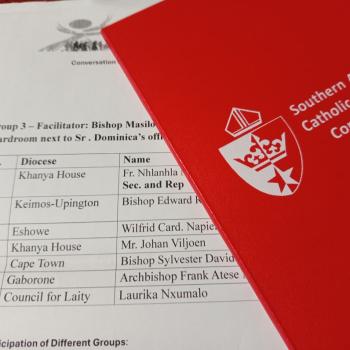By Tim Mooney -- June 22, 2009
Photo: Dry Bones II, by Anne Emmons
"Faith is part of what generates my art and the practice of art-making has taught me a lot about being a Christian," says artist Anne Emmons. Fellow artist Tim Mooney talks with Emmons about faith, creativity and religious truth.
 "Art is my mother tongue," says Anne Emmons without hesitation. "It came before verbal language." Sacred artist Emmons has been a practicing studio artist throughout her adult life, only slowing down when children and family took precedence. She earned a Bachelors degree in Fine Art and is close to finishing a Masters in Fine Art at Azusa Pacific University, a pioneer arts program for Christian Universities. She has taught art her entire adult life and has been teaching drawing and watercolor at Red Rocks Community College in Denver, Colorado for the past fifteen years.
"Art is my mother tongue," says Anne Emmons without hesitation. "It came before verbal language." Sacred artist Emmons has been a practicing studio artist throughout her adult life, only slowing down when children and family took precedence. She earned a Bachelors degree in Fine Art and is close to finishing a Masters in Fine Art at Azusa Pacific University, a pioneer arts program for Christian Universities. She has taught art her entire adult life and has been teaching drawing and watercolor at Red Rocks Community College in Denver, Colorado for the past fifteen years.
Mooney: Anne, how does your art and faith intersect?
Emmons: Faith is part of what generates my art and the practice of art-making has taught me a lot about being a Christian. It's an area of tension for me. In my art circles I'm sometimes faced with defending or hiding my faith, and in my Christian circles I'm sometimes faced with defending or hiding my art.
Mooney: You are reading my mind. One of the questions I wanted to ask you is about the tension between art's creativity and originality and religious truth. Is your art only illustrative of Christian truth already revealed, or can your art be revelatory of something new?
Emmons: To offer a simple answer to your question, if art is a gift from God, and I believe it is, and if one trusts in God, then yes, art can be revelatory. Art, and its images, are a means, a language. The creation and use of images and symbols is way more than just my personal expression. The potential is there for revelation, or an unlayering or uncovering of truth not yet expressed. I would also say that's a life-long process, not just a one-time thing.
Mooney: What is the role of visual art in faith and theology?
Emmons: It really depends on one's theology. Some theologies do not accommodate art. Initially it might welcome art and beauty, but when you scratch below the surface of these theologies, there is quite little room for art and its revelatory potential. What is their theology of beauty? It really needs to start here, or else art becomes superficial, just someone's personal taste.
Mooney: It's as if visual art is simply decoration and nothing more.
Emmons: Yes, decoration as opposed to being integral to the faith. Image and image-making is not a side conversation. Christians of all kinds yearn for beauty and images; even in the most image suspicious traditions, there still exists a desire for icons, ways for God to be symbolized through aesthetics. God knows this about us, made in God's image, so images are essential to us.
Mooney: You said earlier that the practice of art making has taught you a lot about being a Christian. What has being an artist taught you about God?
Emmons: Christianity is a practice and a life-long journey. It's not just hearing or thinking. It demands doing, acting, and a hands-on engagement with the materials you're working with. There's a certain amount of risk-taking and learning from mistakes that happens on a daily level. The hours I spend in the studio open me up to how God is working in my life. It's more a practice than a philosophy. I often say to my students, "Just keep making marks on the paper." You can't learn anything without the actual doing, the actual making of marks in one's life and faith.
Mooney: The painting of yours that drew me to your work was Dry Bones II. Tell me about this work.
Emmons: At the time I was thinking about healing, and working on a painting helps me to understand things. I was in church at Pentecost and the pastor read the story of Ezekial prophesying to a valley full of dry bones, and the bones came to life, with sinew, muscle, skin, and became a living army. I didn't hear another word the pastor said, because an image immediately came of a woman with her back turned arising from the dry bones. The image haunted me. From bones to fullness; the image held a sense of mystery, captured in a heavenly mist descending of the female figure. It became a whole project for me trying to interpret this images meaning for me and interpreting it into a painting. After working on it I asked myself, "What is this saying to me?" As I reflected it seemed to say just as Eve came to life, just as the church came to life, so we can come to life. I find that when I'm working on a piece meanings come to me. It's a dynamic process. I have intentions, but as I work on it, I pick up clues and meanings. It's listening, praying, and working, trying to hear more. A good work has to have that room for the more, for the Spirit. It's a way of giving myself to it. The work changes me.




